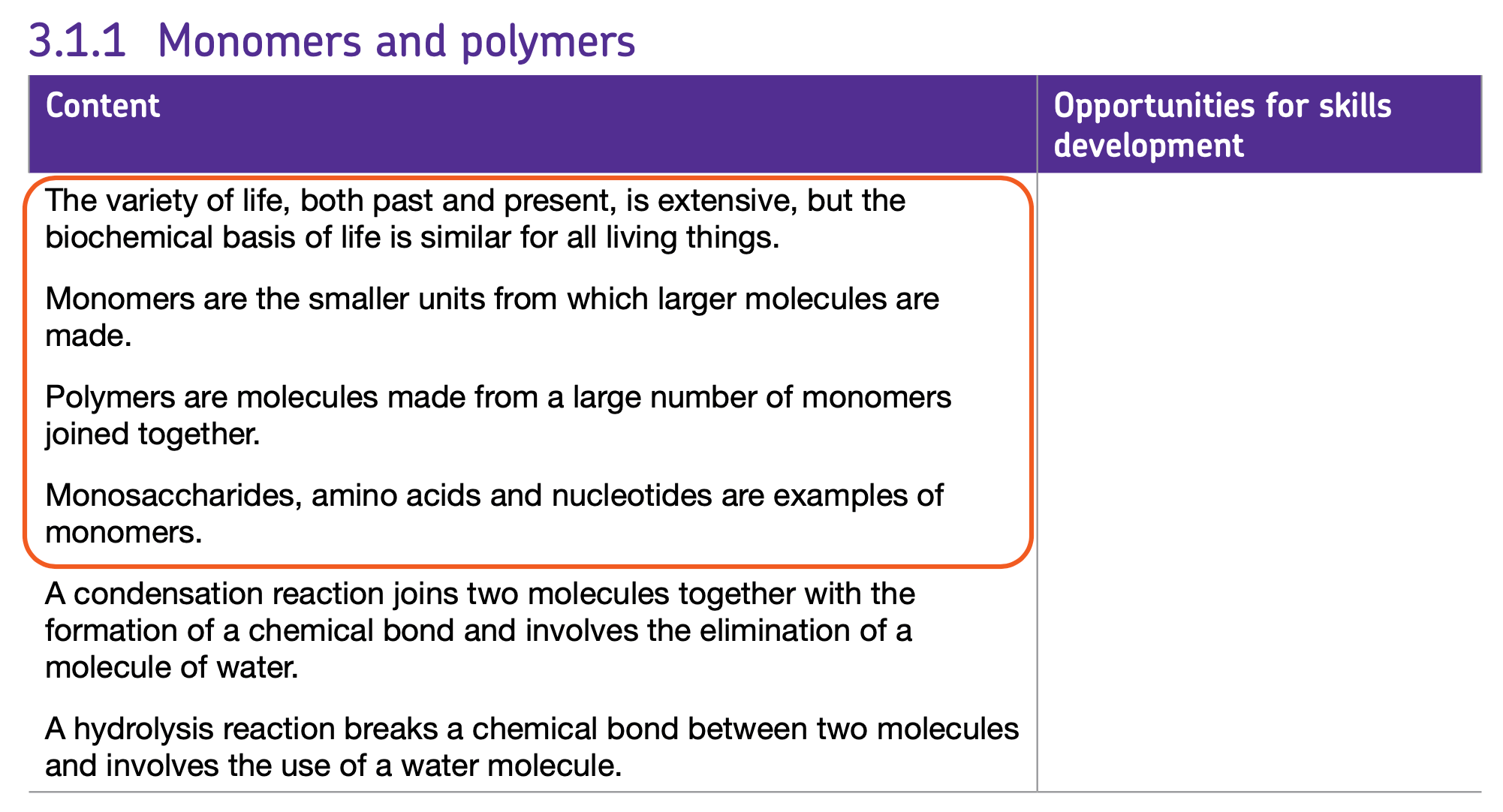LEARN & MAKE NOTES
A concise video lesson covering everything you need to know as quickly as possible
TEST YOUR KNOWLEDGE
Use the quiz to check your knowledge and as a way of strengthening your learning
TEST YOUR UNDERSTANDING
This is what you’re aiming for – can you apply your knowledge to an exam question?
VIDEO TRANSCRIPT
The Biological Molecules – TRANSCRIPT
So, ‘The Biological Molecules’ is a super common topic in A level. It overlaps in so many places in the spec that it’s constantly revisited.
As always in A level Biology, we’ve got some key terms to get into:
Monomer and polymer.
Now, there are certain key terms that you’re going to need to be able to recall and give a definition of in the exam. Fortunately, that’s not many of them and I’ll make sure I point those out when you do. The other key terms are all going to be highlighted in red. You need to know what they are and you need to be able to use them, but you probably won’t be asked to give a definition of them in the exam.
A monomer is a small repeating unit or molecule from which polymers are made. Okay. So I have seen some mark schemes not except the term ‘building blocks’. Often, monomers are referred to as ‘building blocks’ of polymers, but I have seen mark schemes mark them down. So it’s best to say a ‘repeating unit’. ‘Mono’ means one and ‘mer’ means unit. That’s effectively what the word means.
Let’s look at polymers.
So a polymer is a large molecule made up from many repeating monomers. Okay, so I’m going to give some examples here and do a tiny little diagram. Examples of polymers that we need to be aware of as A level biologists are: DNA; We also have RNA;
We could have any of the polymers of carbohydrates (I’ll just use cellulose as an example); All of the proteins are polypeptides and these are terms that you’ll get familiar with as we go through the course. Loads and loads of key terms and jargon and it’s important that we at least know and understand the vast majority of them. So, if we were sketching them, the analogy that I’d like to use is a monomer as being like a single train carriage and the polymer is the train. (I’m going to draw dotted lines because it’s sort of going to continue). This is a monomer joined together by a bond to another monomer, to another monomer, to another monomer and it repeats. So hence the repeating units. Now, because it has to repeat, lipids or ATP are common biological molecules, but they are not polymers because they don’t have this repeating structure.
So let’s label this guy up. The entire molecule here is the polymer. And an individual one of these things is the monomer.
So let’s delve in and look in a little bit more detail at some polymers.
Okay, so I’m going to draw this in a table. So, I will get the video speeded up so you don’t have to watch me draw it.
Alright, then let’s fill it in: So, we’ve got the molecule, we’ve got the elements that make up that molecule, what the monomers are, and what the polymers are.
Okay. So first off we’re going to take a look at some carbohydrates.
You’ve probably heard of these guys already.
With these videos, if you can test yourself (like I’m gonna now say what elements are involved in the carbohydrates), if you can use that active recall, pull that information out from your head or at least get two of the three molecules or elements that make them up, then this is all like ‘wins’ you are making extra gains instead of just passively watching and listening and just letting the information sort of wash over you, you won’t retain it as well as if you like challenge yourself to try and pull it out your head before I give it to you. Okay. So the elements are: carbon, hydrogen and oxygen.
Our monomers are called monosaccharides. Again, ‘mono’ is for the one. ‘saccharide’, Anything saccharide is a carbohydrate. Double C in saccharide.
I’m going to sketch alpha glucose. So, the monosaccharides that we need to know are: glucose, fructose and galactose and I’ll go into those in more detail in another lesson.
But I’ll just sketch alpha glucose, just so you have an idea. So these are the only three monosaccharides that you need to know and this one is glucose. So I suppose I can label that there.
And then, obviously, polysaccharides, ‘many’. (Again, Double C).
And examples, (I’m not going to sketch any here, I don’t think I need to) are going to be cellulose, starch and glycogen.
And again, we’ll dig into this in more detail. Starch is actually a mixture of two things amylose and amylopectin but this is a top level detail. We don’t have to go into all the nitty gritty bits, right here.
Okay next molecule. We’ve got proteins. What do we need to know about proteins? Well, the elements involved in proteins are: carbon, hydrogen and oxygen, again. We also have a special one: All proteins contain the element nitrogen which is why nitrogen is so important for life, in general.
And (I’m going to put in brackets) some of them, in fact most of them, but not all of them, have sulphur. The amino acid that contains sulphur is cysteine and these are important in forming disulfide bridges. But, again, this is a top level detail. We don’t need to really know that information. It’s just ‘nice to know’ information.
So these are in absolutely all of them and this one is in basically all of them, but not necessarily (sulphur).
Okay, so the monomers that make up proteins, (again test yourself: Can you just pull that information out your head to start with?) are amino acids.
I’ll just sketch a basic amino acid structure here. So, we’ve got a central carbon with an R Group, which is the bit that’s different on all the different amino acids. We have a hydrogen over the other side. And then we have another carbon here with a double bond O=H.
This is a carboxylic acid group. That’s where the ‘acid’ comes from. And then this is an amine group, which is a nitrogen with two hydrogens. So that’s an amino acid.
Again, we do need to know that structure for the exam. We can call the polymer here ‘polypeptides’ which sometimes basically means exactly the same as protein. Occasionally a protein is made up from multiple polypeptides, like haemoglobin. We say that it has a quaternary structure but a polypeptide is a chain of amino acids. Again, we’re going to get this sort of linear chain, and then it’s going to fold up and form a 3D structure.
And last but not least in terms of the polymers, are the nucleic acids.
Again, can you think of the elements in that?
Well, it is carbon, hydrogen, oxygen… We’ve also got nitrogen and phosphorus. So, C-H-O-N-P. The monomers are called nucleotides. And the basic structural nucleotide is a phosphate group (note: this is the element of phosphorus and this is a phosphate group, which is actually PO4 3-, which we don’t really need to know) which joins on to a pentose sugar, hence the pentagon, five carbons, and then a nitrogenous base, which will be A T C G or U, if it’s RNA. (So, again, we’re going to go into all of these things in more detail, but that’s just the top level design.) And we’ve got DNA and RNA and these are going to form.
DNA is always double-stranded. Well, in fact nearly always, you will come across complementary DNA at some point which is single stranded. But DNA is generally double-stranded, double helix, pretty classic structure. RNA, depending on which type of RNA: messenger RNA, transfer RNA, is either single stranded or you can end up with some double stranded RNA as well. There’s nearly always exceptions to the rule but typically DNA is double stranded and RNA is single stranded.
In fact, I might even give you some examples there: DNA is just called DNA, but we can have messenger RNA and we can also have transfer RNA and they’re the ones we’re going to come across most commonly in the course.
Last but not least, I’m going to do the non-polymers. I’m just going to call them ‘not polymers’. Okay, so this is mostly going to be our lipids which are going to be triglycerides. I’m going to say ‘lipids/triglycerides are not polymers’. Why? Because they are not made from repeating monomers. You might sometimes hear them called ‘macromolecules’, which is just ‘macro’ is large, ‘molecule’. So, large molecule. It’s not a key term that the specs particularly use, so I’m not going to write it down, here.
The elements that are involved in lipids and triglycerides are the same as in carbohydrates. I’ll just put the elements: carbon, hydrogen and oxygen. The same would apply for ATP, and I suppose whilst I’m doing the summary here, ATP: The elements involved in ATP are: carbon hydrogen and oxygen. (So, we’ll notice that absolutely all of the biological molecules have carbon, hydrogen and oxygen). They also have nitrogen in them and they also have phosphorus in them.
So these are the same as the nucleic acids. In fact, we’ll get into the details of that a little bit later on.
And that is your introduction to the biological molecules. You need to know: the elements that are involved; what the basic monomers look like; the monomers glucose, fructose and galactose are required for carbohydrates; the general structure of an amino acid (So we’ve just got this R Group, which is the bit that changes, but all other amino acids share everything else in this formula); nucleotides have this basic structure of the phosphate group the pentose sugar and the nitrogenous base; And lipids not being polymers and the elements involved in each of them.
Carbohydrates, Osmosis, Calculate Percentage Change, Standard Form
Mostly factual recall on the topic of carbohydrates with a tricky little calculation to end.
QUESTION MARK SCHEME
